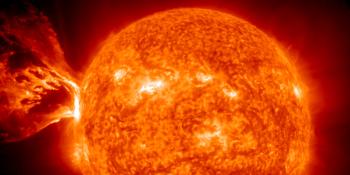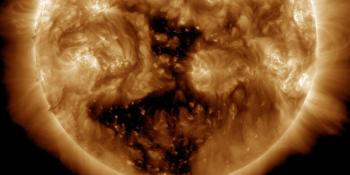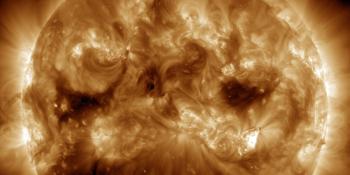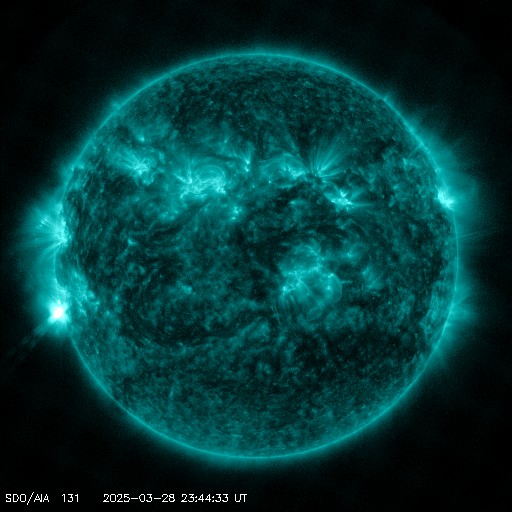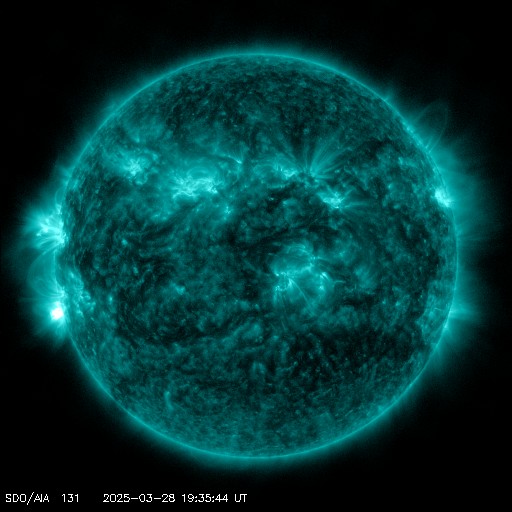Viewing archive of Friday, 5 April 2002
Solar activity report
Any mentioned solar flare in this report has a scaling factor applied by the Space Weather Prediction Center (SWPC). Because of the SWPC scaling factor, solar flares are reported as 42% smaller than for the science quality data. The scaling factor has been removed from our archived solar flare data to reflect the true physical units.
Report of Solar-Geophysical Activity 2002 Apr 05 2200 UTCPrepared by the NOAA © SWPC and processed by SpaceWeatherLive.com
Joint USAF/NOAA Report of Solar and Geophysical Activity
SDF Number 095 Issued at 2200Z on 05 Apr 2002IA. Analysis of Solar Active Regions and Activity from 04-2100Z to 05-2100Z
Solar activity was at low levels. Several weak C-class
flares occurred throughout the period, from sources including most
of the larger active regions on the visible disk. The largest event
of the period was a C4/Sf at 04/2306 UTC, from a source near newly
numbered Region 9895 (N06E58). Two other regions were numbered
today, 9894 (N14W09), and 9896 (S11E74). Newly numbered Region 9896
appears to be the return of old Region 9866, which was a source of
several energetic flares on its last transit. It now appears as a
large, single polarity spot (possibly the leading spot of a large
bipolar group), though lacks any evident bright plage area as would
be expected for an energetic region. It's present position near the
east limb prevents detailed analysis.
IB. Solar Activity Forecast
Solar activity is expected to be
predominantly low to moderate, though a chance for an isolated major
flare exists, particularly for the emergent regions near the east
limb.
IIA. Geophysical Activity Summary 04-2100Z to 05-2100Z
The geomagnetic field was predominantly quiet, with an isolated
unsettled period observed at higher latitudes during 05/1800-2100
UTC. The greater than 2 MeV electron flux observed at
geosynchronous orbit was again at high levels today.
IIB. Geophysical Activity Forecast
Geomagnetic activity is
expected to be mainly quiet to unsettled. A chance for isolated
active periods exists for days two and three of the forecast period.
Greater than 2 MeV electron flux is expected to remain above event
threshold for most of the period.
III. Event Probabilities 06 Apr to 08 Apr
| Class M | 60% | 60% | 60% |
| Class X | 05% | 05% | 05% |
| Proton | 05% | 05% | 05% |
| PCAF | green | ||
IV. Penticton 10.7 cm Flux
Observed 05 Apr 217 Predicted 06 Apr-08 Apr 215/210/205 90 Day Mean 05 Apr 203
V. Geomagnetic A Indices
Observed Afr/Ap 04 Apr 006/008 Estimated Afr/Ap 05 Apr 004/006 Predicted Afr/Ap 06 Apr-08 Apr 008/008-010/010-012/012
VI. Geomagnetic Activity Probabilities 06 Apr to 08 Apr
| A. Middle Latitudes | |||
|---|---|---|---|
| Active | 10% | 15% | 20% |
| Minor storm | 01% | 01% | 05% |
| Major-severe storm | 01% | 01% | 01% |
| B. High Latitudes | |||
|---|---|---|---|
| Active | 15% | 15% | 20% |
| Minor storm | 01% | 01% | 05% |
| Major-severe storm | 01% | 01% | 01% |
All times in UTC
Current data suggests there is a slight possibility for aurora to appear at the following high latitude regions in the near future
VorkutaLatest news
Latest forum messages
AR4046 127Incoming & Unnumbered Active Regions 1657Aurora photography hints for those of us with smartphones 49Large Coronal Hole 25 178LASCO Data Not Updating 5
More topicsSupport SpaceWeatherLive.com!
A lot of people come to SpaceWeatherLive to follow the Sun's activity or if there is aurora to be seen, but with more traffic comes higher server costs. Consider a donation if you enjoy SpaceWeatherLive so we can keep the website online!

Latest alerts
00:00 UTC - Solar flare
Moderate M1.79 flare
Friday, 28 March 2025
23:36 UTC - Radio Blackout
Minor R1 radio blackout in progress (≥M1 - current: M1.04)
21:24 UTC - Hemispheric Power Index
The OVATION model predicts the Hemispheric Power Index to reach 51GW at 21:59 UTC
19:45 UTC - Solar flare
Moderate M1.16 flare
19:27 UTC - Radio Blackout
Minor R1 radio blackout in progress (≥M1 - current: M1.1)
Space weather facts
| Last X-flare | 2025/03/28 | X1.1 |
| Last M-flare | 2025/03/28 | M1.7 |
| Last geomagnetic storm | 2025/03/27 | Kp5 (G1) |
| Spotless days | |
|---|---|
| Last spotless day | 2022/06/08 |
| Monthly mean Sunspot Number | |
|---|---|
| February 2025 | 154.6 +17.6 |
| March 2025 | 128.3 -26.4 |
| Last 30 days | 128.3 -23.7 |
